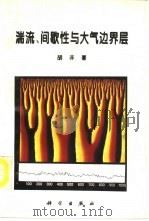《湍流》
| 作者 | Uriel Frisch著 编者 |
|---|---|
| 出版 | 世界图书出版公司北京公司 |
| 参考页数 | 296 |
| 出版时间 | 1998(求助前请核对) 目录预览 |
| ISBN号 | 7506238233 — 求助条款 |
| PDF编号 | 81402068(仅供预览,未存储实际文件) |
| 求助格式 | 扫描PDF(若分多册发行,每次仅能受理1册) |

CHAPTER 1Introduction1
1.1 Turbulence and symmetries1
1.2 Outline of the book11
CHAPTER 2Symmetries and conservation laws14
2.1 Periodic boundary conditions14
2.2 Symmetries17
2.3 Conservation laws18
2.4 Energy budget scale-by-scale21
CHAPTER 3Why a probabilistic description of turbulence?21
3.1 There is something predictable in a turbulent signal27
3.2 A model for deterministic chaos31
3.3 Dynamical systems36
3.4 The Navier-Stokes equation as a dynamical system37
CHAPTER 4Probabilistic tools:a survey40
4.1 Random variables40
4.2 Random functions45
4.3 Statistical symmetries46
4.4 Ergodic results49
4.5 The spectrum of stationary random functions52
CHAPTER 5Two experimental laws of fully developed turbulence52
5.1 The two-thirds law57
5.2 The energy dissipation law67
CHAPTER 6The Kolmogorov 1941 theory72
6.1 Kolmogorov 1941 and symmetries72
6.2Kolmogorov's four-fifths law76
6.2.1 The Kámán-Howarth-Monin relation for anisotropic turbulence77
6.2.2 The energy flux for homogeneous turbulence79
6.2.3 The energy flux for homogeneous isotropic turbulence81
6.2.4 From the energy flux relation to the four-fifths law84
6.2.5 Remarks on Kolmogorov's four-fifths law86
6.3Main results of the Kolmogorov 1941 theory89
6.3.1 The Kolmogorov-Obukhov law and the structure func-tions89
6.3.2 Effect of a finite viscosity:the dissipation range91
6.4Kolmogorov and Landau:the lack of universality93
6.4.1 The original formulation of Landau's objection93
6.4.2 A modern reformulation of Landau's objection94
6.4.3 Kolmogorov and Landau reconciled?97
6.5 Historical remarks on the Kolmogorov 1941 theory98
CHAPTER 7Phenomenology of turbulence in the sense of Kolmogorov 1941100
7.1 Introduction100
7.2 Basic tools of phenomenology101
7.3 The Richardson cascade and the localness of interactions103
7.4 Reynolds numbers and degrees of freedom106
7.5 Microscopic and macroscopic degrees of freedom109
7.6 The distribution of velocity gradients111
7.7 The law of decay of the energy112
7.8 Beyond phenomenology:finite-time blow-up of ideal flow115
CHAPTER 8Intermittency120
8.1 Introduction120
8.2 Self-similar and intermittent random functions121
8.3 Experimental results on intermittency127
8.4 Exact results on intermittency133
8.5Intermittency models based on the velocity135
8.5.1 The β-model135
8.5.2 The bifractal model140
8.5.3 The multifractal model143
8.5.4 A probabilistic reformulation of the multifractal model146
8.5.5 The intermediate dissipation range and multifractal universality149
8.5.6 The skewness and the flatness of velocity derivatives according to the multifractal model155
8.6Intermittency models based on the dissipation159
8.6.1 Multifractal dissipation159
8.6.2 Bridging multifractality based on the velocity and mul-tifractality based on the dissipation163
8.6.3 Random cascade models165
8.6.4 Large deviations and multifractality168
8.6.5 The lognormal model and its shortcomings171
8.7 Shell models174
8.8 Historical remarks on fractal intermittency models178
8.9Trends in intermittency research182
8.9.1 Vortex filaments:the sinews of turbulence?185
8.9.2 Statistical signature of vortex filaments:dog or tail?188
8.9.3 The distribution of velocity increments192
CHAPTER 9Further reading:a guided tour195
9.1 Introduction195
9.2 Books on turbulence and fluid mechanics195
9.3 Mathematical aspects of fully developed turbulence199
9.4 Dynamical systems,fractals and turbulence203
9.5Closure,functional and diagrammatic methods206
9.5.1 The Hopf equation207
9.5.2 Functional and diagrammatic methods212
9.5.3 The direct interaction approximation217
9.5.4 Closures and their shortcomings219
9.6Eddy viscosity,multiscale methods and renormalization222
9.6.1 Eddy viscosity:a very old idea222
9.6.2 Multiscale methods226
9.6.3 Applications of multiscale methods in turbulence230
9.6.4 Renormalization group(RG)methods235
9.7Two-dimensional turbulence240
9.7.1 Cascades and vortices241
9.7.2 Two-dimensional turbulence and statistical mechanics243
9.7.3 Conservative dynamics‘punctuated’by dissipative events249
9.7.4 From Flatland to three-dimensional turbulence251
References255
Author index283
Subject index289
1998《湍流》由于是年代较久的资料都绝版了,几乎不可能购买到实物。如果大家为了学习确实需要,可向博主求助其电子版PDF文件(由Uriel Frisch著 1998 世界图书出版公司北京公司 出版的版本) 。对合法合规的求助,我会当即受理并将下载地址发送给你。
高度相关资料
-

- 湍流反应流的PDF模拟
- 1996 武汉:华中理工大学出版社
-

- 湍流射流理论与计算
- 1975
-

- 急湍
- 民国25.07 联合出版社
-

- 湍流
- 1998 世界图书出版公司北京公司
-

- 湍流与润滑
- 1983 上海:上海科学技术文献出版社
-

- 湍浮力射流与羽流
- 1991 北京:海洋出版社
-

- 湍流模型及有限分析法
- 1989 上海:上海交通大学出版社
-

- 随机函数和湍流
- 1976 北京:科学出版社
-

- 湍流、间歇性与大气边界层
- 1995 北京:科学出版社
-

- 湍流射流理论与计算
- 1975 北京:科学出版社
-

- 孤波和湍流
- 1994 上海:上海科技教育出版社
-

- 湍流 下
- 1987 北京:科学出版社
-

- 湍流 上
- 1987 北京:科学出版社
-

- 湍流计算模型
- 1991 合肥:中国科学技术大学出版社
提示:百度云已更名为百度网盘(百度盘),天翼云盘、微盘下载地址……暂未提供。➥ PDF文字可复制化或转WORD
